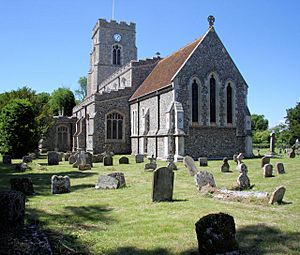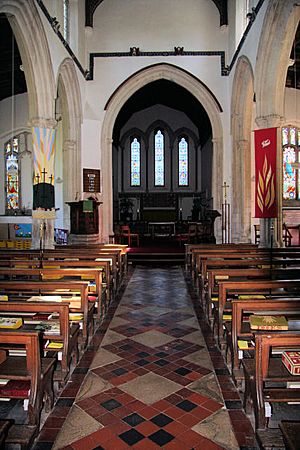All Saints' Church, Lawshall facts for kids
Quick facts for kids All Saints' Church, Lawshall |
|
|---|---|

All Saints' Church, Lawshall, a Grade 1 Listed Building
|
|
| Lua error in Module:Location_map at line 420: attempt to index field 'wikibase' (a nil value). | |
| OS grid reference | TL8643654260 |
| Location | Lawshall, Suffolk |
| Country | England |
| Denomination | Anglican |
| Website | St Edmund Way Benefice, Lawshall Church |
| History | |
| Dedication | All Saints |
| Architecture | |
| Functional status | Active |
| Heritage designation | Grade I |
| Designated | 23 March 1961 |
| Architect(s) | William Butterfield (restorations) |
| Architectural type | Church |
| Specifications | |
| Materials | Flint with stone dressings. |
| Administration | |
| Parish | Lawshall |
| Archdeaconry | Sudbury |
| Diocese | St Edmundsbury and Ipswich |
| Province | Canterbury |
All Saints' Church is an Anglican church in Lawshall, a village in Suffolk, England. It's a very old and important building, officially called a Grade I listed building by English Heritage. You can find it between Lawshall Hall and All Saints CEVCP Primary School. The church is part of the Chadbrooke benefice, led by Reverend Matthew Lawson.
Contents
A Look Back: Church History
The Domesday Book from 1086 mentions a church in Lawshall. This means people have likely been worshipping here for a very long time. Like many old churches, this building has changed a lot over the centuries. The biggest changes happened in the 1440s and the 1850s.
The oldest part of the church that we can date is from the Early English period (around 1166–1266). This includes the chancel and possibly the east windows. Most of the church, especially the aisle windows, was built in the Perpendicular style (around 1366–1566).
Building in the 1400s
The church was almost completely rebuilt in the mid-1400s. This was possible because of money from the cloth industry. A lot of rebuilding happened in the 1440s after William Hanningfield left £40 in his will in 1426. This money was for "the building of Lawshall Church" so his ancestors would be remembered in prayers. £40 was a huge amount back then, worth millions today!
Before the Reformation, All Saints' was a Catholic church. After the Reformation, it became an Anglican church where sermons were preached.
The Church in Later Centuries
Records from the Late Middle Ages and Early Modern period are not very detailed. However, in the 1700s, we have more information from parish records. Stephen Cambourne, who was the rector (a type of priest) in 1704, left his collection of mostly religious books to the church. About 137 of these books still exist and can be seen at the Records Office library in Bury St Edmunds.
In 1735, the church bells were put back in the tower after being silent for 90 years. The first bells were there in 1553 but were removed around 1650 during the English Civil War. In 1740, the church received the vicarage house as a gift. This house was later rebuilt as a school in 1820.
The famous artist Thomas Gainsborough painted the church in 1752. His painting shows John Plampin looking towards Lawshall from Chadacre Park. This oil painting is now on display at the National Gallery.

Major Changes in the 1800s
During the 1800s, when farming was doing well, the church had its most important restoration in over 100 years. William Butterfield, a famous architect, led this work. The rector, Evan Baillie, spent £3,000 of his own money to rebuild the chancel and add new windows. Just nine months after this work was finished, Baillie left his job. He became a teacher at a Roman Catholic chapel nearby.
In the 1850s, the church got a new wooden floor and beautiful Minton tiles in the sanctuary (the area around the altar). The high-quality organ was installed in 1907. It was put there to remember Barrington Mills, who was a very important rector.
There are not many memorials inside the church. Some were removed during the 1857 restoration, and others were covered by the new tiles. Near the font, there is a plaque for Johannes Bartholomeus Jat Van Mesdag, a Dutch airman whose plane crashed nearby. On the opposite wall, you can see a list of all the rectors since 1306.
The churchyard also has the war grave of a British airman from World War II. The church's records of baptisms, marriages, and burials go all the way back to December 1558.
Church Design and Features
This church, built mostly in the 1400s, is made of Flint with stone details. It has a tall west tower, a main area called the nave, side aisles, and a chancel that was rebuilt in the 1800s. The west tower has four levels with a decorative top and strong supports called buttresses. The nave and aisles also have decorative tops.
Inside, the church has beautiful roofs in the nave and aisles with carved beams. The nave also has a carved border at the top of the walls. Inside, you can find a font from the 1300s and a carved chest from the 1500s. The church is a Grade I Listed Building because of its important design, history, and location.
Key Parts of the Church
- The Porch: The porch at the South door was rebuilt in 1856–57. It was made in the style of the 1400s, using some old medieval wood in the roof. The carvings on the roof and the stone doorway are very well made.
- The Tower: The tower holds five bells. The oldest bell dates back to 1755.
- The Font: The beautiful font, decorated with flowers, is from the 1440s. Its cover was added in 1856.
- The North Doorway: This doorway is from the Decorated period (1300–1380).
- The Nave, Clerestory, and Aisles: The impressive arches of the nave, with aisles on each side and windows above (called a clerestory), were built in the 1440s. This was thanks to the money from William Hanningfield.
- The Chancel: An early drawing of the church from the 1810s shows a low chancel with a round Norman doorway. This was part of the original Domesday church. The chancel was taken down and rebuilt in the mid-1800s, thanks to a gift from Rector Evan Baillie. During this time, the organ and gallery were moved, the font was placed in its current spot, and new oak pews and a pulpit were added. A new window in the Early English style was also put at the east end.
St Edmund Way Benefice
All Saints' Church in Lawshall is part of a group of six Anglican churches called the St Edmund Way Benefice. This group includes churches in Bradfield Combust, Great Whelnetham, Hawstead, Lawshall, Nowton, and Stanningfield. You can find out about service times in the monthly St Edmund Way magazine or on the St Edmund Way website. The current leader is Jayne Buckles, who lives at Lawshall Rectory.
The Benefice is named after the St Edmund Way Long Distance Path. This path goes through these parishes on its way to Bury St Edmunds. In the past, Pilgrims would walk this path to visit the Bury St Edmunds Abbey.
Important Rectors of Lawshall
Records show the rectors of All Saints Church from 1306. The first was Jo Gossyl, appointed by the Bishop of Norwich, who served from 1306 to 1310.
Evan Baillie's Contributions
In 1856, Evan Baillie, the rector of Lawshall, received a large amount of money. He spent over £3,000 to restore the church. This allowed the chancel to be taken down and rebuilt. However, just nine months after the church was restored, Baillie left his position. He became a teacher at a Roman Catholic chapel nearby. He had published a collection of twelve sermons, which he said did not go against the Church of England's beliefs. He dedicated them to Thomas Sargeant, one of his churchwardens, who had supported him during a difficult time.
Barrington Mills' Influence
Barrington Mills took over as rector in 1858 and had a strong impact on the village. He would visit every person who missed Sunday service, which likely helped more people attend. With the help of Mr. and Mrs. Frost, he started daily services at the church. Mrs. Frost was the headmistress of the school, and Mr. Frost was the organist. The school provided the choir, and any boys who didn't attend choir practice would lose money from their yearly payment of £1. Mills was also very kind. When he went on seaside holidays, he would arrange for a cartload of fish to be delivered to the village for his parishioners.
Canon Algernon Ogle Wintle
In 1923, Canon Algernon Ogle Wintle became the rector of Lawshall. He was known for playing street pianos in Bury St Edmunds to raise money for charity. After a radio broadcast, many small barrel organs were sent to him for repair. Canon Wintle then set up a workshop to fix these organs. This provided jobs for many local people in the village during the 1930s depression. He would buy used organs, fix them up, and sell them under his own name. People remembered him as a round, sometimes grumpy man, whose workshop was full of barrel pianos. Women from the village would bring their organs to his house for him to add the latest tunes. He also gave talks on BBC Radio and met Queen Elizabeth and the Queen Mother at Sandringham House in 1954.
Gallery
References
An acknowledgement is made to the work of Elizabeth Clarke, the Local History Recorder for Lawshall, whose endeavours obtaining and collating information from various sources has made this article possible.






